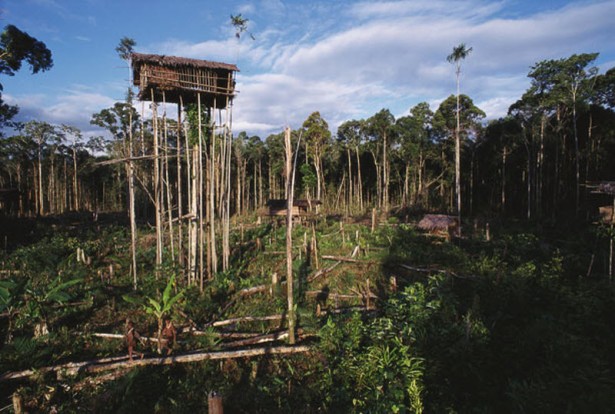 |
| Until the 1970's they were unaware that another world exists. |
The Korowai tribe are direct neighbours of the Asmat and live north of the Dairam Kabiur. Their habitat is limited by two large rivers and the mountains in the north. Their swampy area is approximately 600 km² bid. In this difficult area are living up to 2500 Korowai together in small family groups. The Korowai are hunters and collectors. They nourish themselves mainly with Sago which they won from Sago palms. They refer their main protein food from the larvae of the Capricorn beetle. The huntable animals represent their further base of live. There are wild pigs; Casuar bird; birds; snakes; and small insects. Vegetable food is also very important for them. Especially palm leaves, fern, breadfruit and the red pandanae fruit.
Language:
The language of korowai is the part of the Awyu-Dumut family, which is the language of the southern-eastern Paupa. A Dutch missionary Linguist has prepared the dictionary and grammar for this language.
Economy:
Most of the Korowai people are hunters who gather their food and have excellent hunting and fishing skills. These people love gardening and are now shifting towards cultivation. The trade in this part of the world is imminent and we don’t have much information about it. The Korowai have a few gender-specific activities, such as the preparation of a specific type of food named “Sago” and the performance of religious ceremonies in which only the male adults are involved. Some Korowai have since the early 1990s generated moderate cash income by working with tour companies selling tours into the Korowai region. Within the tourist industry, opportunities are limited to hosting tour groups in villages for tourist-sponsored sago feasts, carrying luggage, and performing traditional displays.

Ways of Living and Social Life:
The majority of the Korowai families live in the tree houses they build for themselves. Since 1980 some have moved into the recently opened villages of Yaniruma at the Becking River, Mu, and Mbasman. Leadership structures are based on personal qualities of Strong men rather than on institution. Interclan warfare occurs mainly because of witchcraft and sorcery related conflicts.Marriages:
The Patriclan is a system in which one belongs to one's father's lineage. It generally involves the inheritance of property, names or titles through the male line as well. This is the central unit with respect to social, economic, and political organization. In Korowai society the forms of institutional levirate and predominance of avuncular relationships are found, as well as a kind of affinal avoidance relationships. During Marriages preference is given to a conjugal relationship with the mother's mother's brother's daughter.
Religious Life:
The Korowai universe is filled with all kinds of spirits, some more personal of character than others. Reverence is paid especially to the ancestors. To Ginol Silamtena, the creator spirit, the Korowai do not ascribe an important role in their daily lives. Once in a lifetime a Korowai clan must organize a sago grub festival in order to stimulate prosperity and fertility in a ritual fashion. In times of trouble they sacrifice pig to the spirits of the ancestors. The Korowai have an extraordinary and rich oral tradition: myths and folktales sayings and charms, and traditions. With respect to death and afterlife the Korowai believe in the existence of a reciprocal type of reincarnation those who died can be sent back at any time to the land of the living, by their kinsmen in the land of the dead, in order to reincarnate in a newly born infant of their own clan.
Contact with Outer World:
In the late 1970s, a few Christian missionaries began to live among the Korowai. Dea Sudarman, an Indonesian anthropologist, made several documentary films on the Korowai for Japanese television in the 1980s. In 1993, a film crew documented an anthropological study in the Dayo village area by the Smithsonian Institution of Korowai treehouse construction and the practice of cannibalism as a form of criminal justice. This resulted in the film Lords of the Garden. In 1996 a local Christian community was established, the members of it mainly originating from the neighboring Kombai people. For a long time the Korowai have been considered exceptionally resistant to religious conversion; however, by the end of the 1990s the first converts to Christianity were baptized. In the autumn of 2003, a small team of Bible translators from Wycliffe/SIL moved to Yaniruma.Cannibalism:
The Korowai have been reported to practice ritual cannibalism up to the present day. Anthropologists suspect that cannibalism is no longer practiced by the Korowai clans that have had frequent contact with outsiders. Recent reports suggest that certain clans have been coaxed into encouraging tourism by perpetuating the myth that it is still an active practice.




No comments:
Post a Comment